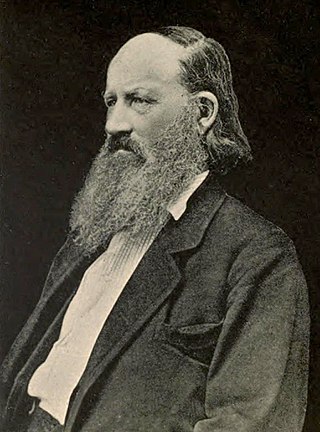In Hawaiian mythology, Lalo-Honua is the first woman.
In Hawaiian mythology, Nāmaka appears as a sea goddess in the Pele family. She is an older sister of Pele-honua-mea.
Hawaiʻiloa is a mythical Hawaiian fisherman and navigator who is said to have discovered the island of Hawaiʻi.
Folklore in Hawaii in modern times is a mixture of various aspects of Hawaiian mythology and various urban legends that have been passed on regarding various places in the Hawaiian islands. The following is a partial list of some of these legends.

Abraham Fornander was a Swedish-born emigrant who became an important journalist, judge, and ethnologist in Hawaii.

Kameʻeiamoku was a Hawaiian high chief and the Counselor of State to King Kamehameha I. He was called Kamehameha's uncle, but he was really the cousin of Kamehameha's mother, Kekuiapoiwa II.

Charles Kanaʻina, was an aliʻi of the Kingdom of Hawaii, prince consort of Kuhina Nui, Kaʻahumanu III and father of William Charles Lunalilo, the 6th monarch of the Kamehameha Dynasty. Kanaʻina was a descendant of several figures from ancient Hawaiian history, including Liloa, Hakau and Umi-a-Liloa of Hawaiʻi Island as well as Piilani of Maui. He served on both the Privy Counsel and in the House of Nobles. He was named after his uncle Kanaʻina, a name that means "The conquering" in the Hawaiian Language. This uncle greeted Captain James Cook in 1778 and confronted the navigator before he was killed.
Kahekili I was a chief of Maui. Kahekili was a noted warrior chief who was styled Kahekilinui or "Kahekili the Great", even though his greatness was small in comparison to his descendant Kahekili II. His name was short for Kāne-Hekili after the Hawaiian god of thunder.

Hawaiian religion refers to the indigenous religious beliefs and practices of native Hawaiians, also known as the kapu system. Hawaiian religion is based largely on the tapu religion common in Polynesia and likely originated among the Tahitians and other Pacific islanders who landed in Hawaiʻi between 500 and 1300 AD. It is polytheistic and animistic, with a belief in many deities and spirits, including the belief that spirits are found in non-human beings and objects such as other animals, the waves, and the sky. It was only during the reign of Kamehameha I that a ruler from Hawaii island attempted to impose a singular "Hawaiian" religion on all the Hawaiian islands that was not Christianity.
Peleʻioholani (1690–1770) was a Hawaiian High Chief, the 21st Aliʻi nui of Kauai and the 25th Aliʻi nui of Oahu. He ruled an empire stretching from Niʻihau to Molokaʻi. According to ancient traditions, Peleʻioholani was a descendant of Hema and Māweke.
Kaneʻalai was a Queen regnant of the Hawaiian island of Molokai, who lived in the 18th century. She ruled as Alii nui of Molokai.

Energy in the U.S. state of Hawaii is produced from a mixture of fossil fuel and renewable resources. Producing energy is complicated by the state's isolated location and lack of fossil fuel resources. The state relies heavily on imports of petroleum; Hawaii has the highest share of petroleum use in the United States, with 67% of electricity generation in the state coming from petroleum in 2023, compared to less than 1% nationally.

Paul (Paulo) Kanoa was a Hawaiian high chief who served many political posts in the Kingdom of Hawaii, including Governor of Kauaʻi from 1847 to 1877.
Keleanohoanaʻapiʻapi, short name Kelea, was an ancient Hawaiian noblewoman who is mentioned in ancient legends, and her genealogy is given in chants. She was a Princess of Maui, one of the Hawaiian Islands. She was a High Chiefess, but not of the highest known rank.
Mulielealiʻi, also known as Miʻi-i-ele-aliʻi, was an ancient Hawaiian High Chief who lived on the island of Oahu, and is mentioned in ancient chants and writings by Abraham Fornander. His title is Aliʻi Nui.
Chief Kumuhonua was a High Chief in ancient Hawaii, who was Aliʻi Nui ("king") of Oahu, one of the Hawaiian Islands, and is mentioned in the chants. He was named after the first man in Hawaiian mythology.
Pius F. Koakanu was a Hawaiian high chief (aliʻi) from the island of Kauai who served as a politician during the Kingdom of Hawaii and the Kahu or Keeper of the Royal Mausoleum of Hawaii at Mauna ʻAla.
Keawepoepoe was the son and keiki aliʻi of aliʻi nui Lonoikahaupu and aliʻi nui wahine Kalanikauleleiaiwi who became father of the royal twins, Kamanawa and Kameʻeiamoku. He was born sometime in the 1700s and was the youngest child of his mother, who was also the wife and half sister of Keaweʻīkekahialiʻiokamoku. His name means; "round Keawe". Due to his high rank from both parents as well as his father's status as a Kauaian Lono priest, Keawepoepoe was given the kapu o pahenakalani. His lineage through his mother makes him a descendant of Haloa through Keakealanikane.
Kawelo a Maihunaliʻi, also known as Kaweloleimakau, was the usurping aliʻi nui of Kauai, who overthrew Kaweloaikanaka and the old hereditary line of Kauai rulers.

Kaʻiana, also known as Keawe-Kaʻiana-a-ʻAhuʻula, was a Native Hawaiian warrior and aliʻi (noble) of Puna, Hawai‘i, who turned against Kamehameha I in 1795 during his conquest of Oahu and then sided with the island's ruler, Kalanikupule.